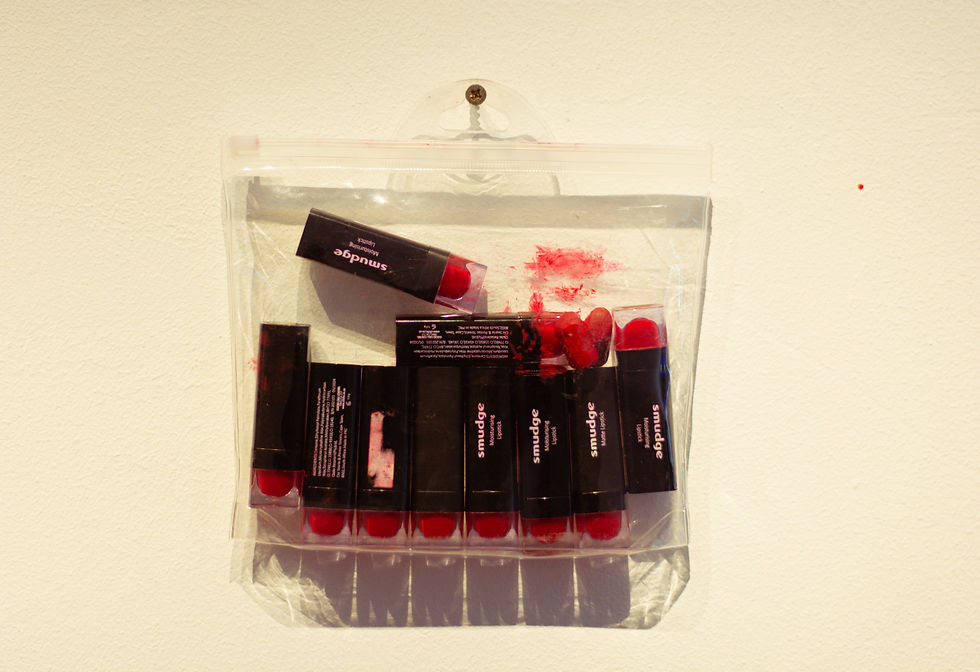



Interlocutor: Phokeng Setai
16.12.2021 - 14.02.2022
Text by Phokeng Setai
My reflections on Brian Montshiwa’s residency at Church Projects 20 December 2021.
A white vest and a pair of tights hug Brian’s diminutive physique. The artist’s melanated skin appears distinct against the pristine white walls; as the iridescent glow coming from the low-hanging ceiling ignites the narrow walls of the studio. Montshiwa Brian, as the artist prefers to be called, stares into Church Street with a piercing gaze; while diligently coating their lips with a red lipstick, in the background Nina Simone’s 1976 live performance of Stars plays in a loop.
What I am describing is one of many encounters I had with the artist, Brian, while in the process of performing their speculative durational performance which spanned a period of five days and lasted a total of seventeen hours and six minutes. The work saw the artist repeat the action of kissing the walls (what we call ‘ho suna lebota’) of the project space. I use the word ‘speculative’ above intentionally to denote the open-endedness of mine and Brian’s collaborative artistic intervention at the newest edition to Cape Town’s art ecosystem, Church Projects.
Prior to engaging Brian for the purposes of their residency at Church Projects, I had known of the artist through social media. Although we followed one another on Instagram, I was not aware of the scope and depth of the artist’s burgeoning artistic practice. Hoosein Mahomed, co-founder of Church Projects, introduced me to Brian’s artistic practice, sharing a video work that the artist created earlier this year, ironically titled Untitled. Untitled is a single channel video piece shot in monochrome in what seems to be Brian’s room. The raw footage depicts the artist shaving their already bald head with a hair clipper— the buzzing of the hair clipper drones incessantly, emitting an unsettling tonality that suggests that there is an impalpable danger looming. This menacing sound juxtaposed with the stark black and white image of Brian’s half-naked body running a hair clipper on their bare scalp, it lends the aesthetic composition of this video a sinister quality. Upon my confrontation with this video work, I was overcome by an anguish whose roots were difficult to trace or even explain.
Subsequently, I was overcome by a rush of excitement because I knew that here was a young artist who, although still raw, was displaying obvious potential. Hoosein had been following 1 Brian’s career for some time—two years, to my understanding, and was very enthusiastic about how the artist’s practice was developing. In the art-world and I would say in the world in general, very few things are as infectious as a person’s passion for what they love. Hoosein, when he speaks about art and artists oozes this passion. It was evident to me from the very beginning that he loved art and, most importantly, saw something special in Brian. I came on board to assist with the project of bringing Brian to Cape Town to begin a residency at Church Projects—my intrigue and curiosity about Brian’s artistic practice were galvanized by Hoosein’s enthusiasm. I soon learnt, yet again through Hoosein, that Brian had a site-specific performance that had been documented on video. The piece was titled Kea iPotsa, a Sesotho phrase which can be translated to mean ‘I am questioning myself’. This site-specific performance was performed in the busy district of Braamfontein, in Johannesburg in the latter stages of 2019.
Kea iPotsa sees Brian, clad in a hot pink mini dress, stalking through the streets in a pair of tall black stilettos— an old television monitor worn over their head like a boxy astronaut’s helmet.
Seemingly ignoring the stares, Brian walks through the crowded streets of Braamfontein trailed by a small group of people, mainly street dwellers (‘Nyaope Boys’) who abandon their aimless perambulations of the business district to loiter in Brian’s wake. As they walk, the artist calls out the names of the queer male characters who were among the first to appear on our local television screens in the mid-2000s, in soap operas such as the legendary Generations; South Africa’s version of the timeless American soapies Days of Our Lives and The Bold and the Beautiful. Simultaneously, as they call out the names of these characters, Brian dispenses with a set of coins which the artist carries in their hand and tosses onto the ground. Partly explaining why the Nyaope Boys were seemingly mesmerised by the ensuing spectacle, they had an outright self-interest which was to gather as many of the coins being thrown down as they could.
“I don’t believe”, “I don’t believe”, “I don’t believe”一is the overarching refrain that Brian chants in intermittent bursts that echo derangedly throughout the 10-minute video documentation of the site-specific performance. The art historical mind will readily identify the reference to white artist Steven Cohen’s performance practice, most notably the famous site-specific Chandelier (2001), in which Cohen meanders through a squatter camp in Newtown, Johannesburg. Cohen wears a sparkly white chandelier on his body and his face is embellished with glittering make-up. Like Brian, the artist Cohen wears a tall pair of Black stilettos, which only further complicate the task of walking through the rubble of the camp. In Brian’s Kea iPotsa, this instability is re-enacted both by the artist’s gait as they walk but also by the unsteady manner in which the videographer 2 documents Brian as they perform the work. Both Montshiwa and Cohen’s site-specific performances seem to subtly allude to the constantly looming dangers that imperil the queer (male) body in the context of South African society.
